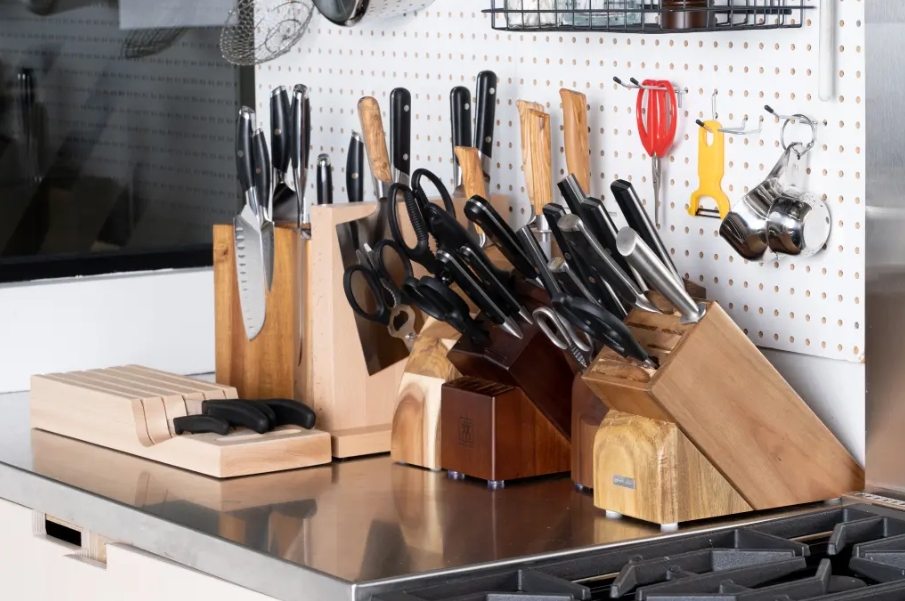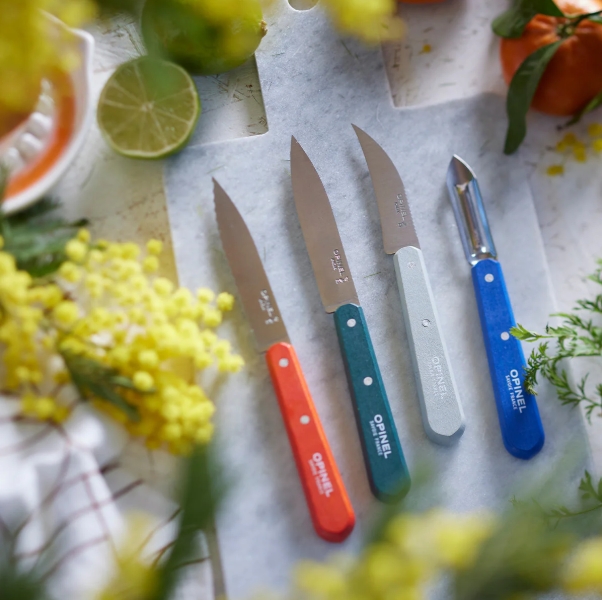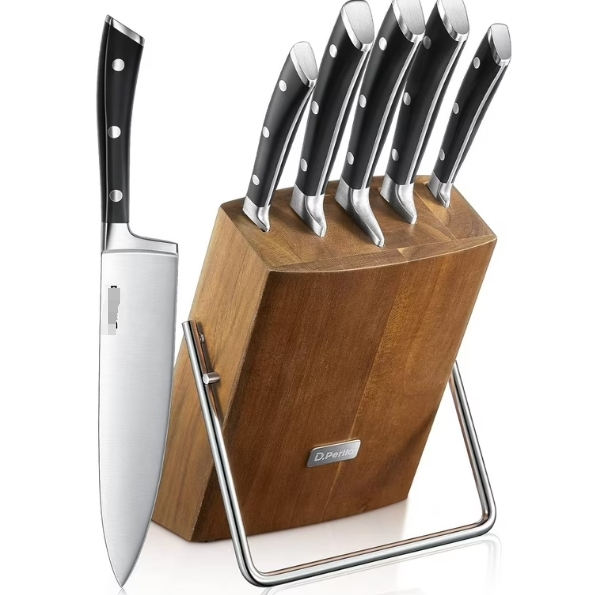

Views: 222 Author: Ella Publish Time: 2025-04-22 Origin: Site








Content Menu
● Key Differences Between a Paring Knife and a Kitchen Knife
● Essential Knife Techniques (With Video)
● FAQ: Top 5 Related Questions
>> 1. Can a paring knife replace a chef's knife for most tasks?
>> 2. What are the most common types of paring knives?
>> 3. How do I choose the right knife for a specific kitchen task?
>> 4. How often should I sharpen my kitchen knives?
>> 5. Is it safe to use a paring knife on a cutting board?
Understanding the differences between a paring knife and a kitchen knife is essential for anyone looking to improve their culinary skills. Whether you're a home cook or a professional chef, knowing which knife to use for each task can make food preparation safer, faster, and more enjoyable. This comprehensive guide will explore the unique features, uses, and advantages of paring knives versus general kitchen knives, complete with illustrative images and videos to enhance your understanding.

Knives are the backbone of any kitchen. Among the vast array of knives available, the paring knife and the kitchen (or chef's) knife are two of the most commonly used. But what sets them apart? Let's dive into their characteristics, uses, and why having both in your kitchen arsenal is crucial.
A paring knife is a small, precise kitchen tool with a blade typically between 2 to 4 inches in length[10][2][18]. Its compact size and pointed tip make it ideal for intricate tasks that require control and finesse, such as:
- Peeling fruits and vegetables
- Deveining shrimp
- Coring tomatoes and apples
- Trimming and shaping small produce
- Creating decorative garnishes
The term "kitchen knife" often refers to the chef's knife, the workhorse of the kitchen. Chef's knives generally have a blade length ranging from 6 to 14 inches, with 8 inches being the most common for home cooks[14][16]. Their broad, slightly curved blades are designed for:
- Chopping, slicing, and dicing vegetables
- Cutting meat and poultry
- Mincing herbs
- General-purpose kitchen tasks
| Feature | Paring Knife | Kitchen/Chef's Knife |
|---|---|---|
| Blade Length | 2–4 inches | 6–14 inches (commonly 8 inches) |
| Blade Shape | Narrow, pointed, often straight | Broad, slightly curved |
| Weight | Lightweight | Heavier, more robust |
| Primary Use | Precision, detail work | General-purpose, heavy tasks |
| Best For | Peeling, coring, trimming, garnishes | Chopping, slicing, dicing |
| Not Ideal For | Large or hard vegetables, meats | Intricate or delicate tasks |
While the chef's knife and paring knife are essential, the kitchen arsenal includes several other types, each with specialized uses[16][4][14]:
- Utility Knife: Blade length 4–7 inches, ideal for slicing fruits, vegetables, and sandwiches; bridges the gap between paring and chef's knives[9][11][16].
- Santoku Knife: Japanese all-purpose knife, slightly shorter and thinner than a chef's knife, excels at slicing, dicing, and mincing[4][16].
- Bread Knife: Serrated blade, perfect for slicing bread and delicate produce[16].
- Boning Knife: Flexible, narrow blade for removing bones and trimming fat[16].
- Cleaver: Heavy, broad blade for chopping through bones and tough ingredients[3][16].

Use a Paring Knife When:
- Peeling apples, potatoes, or citrus
- Deveining shrimp or removing seeds
- Creating decorative garnishes
- Trimming small fruits and vegetables
- Tasks requiring fine control and precision[1][2][10][18]
Use a Kitchen/Chef's Knife When:
- Chopping onions, carrots, celery, or other large vegetables
- Slicing meat, poultry, or fish
- Dicing herbs or nuts
- Preparing large quantities of ingredients
- Tasks requiring power and speed[14][16]
Mastering knife skills is fundamental for safety and efficiency in the kitchen. Here are some key techniques for each knife:
- Peeling: Hold the fruit or vegetable in your non-dominant hand and use the paring knife to peel towards yourself with gentle, controlled motions[2][10].
- Coring: Insert the tip of the knife around the core in a circular motion, then pop the core out[2].
- Deveining: Make a shallow incision along the back of shrimp and lift out the vein with the tip[2].
- Rocking Chop: Use the curved blade to rock back and forth for efficient chopping.
- Slicing: Use smooth, forward-and-back motions for even slices.
- Dicing: Slice, then rotate and chop for uniform cubes.
Proper care extends the life and sharpness of your knives:
- Hand wash knives with warm, soapy water and dry immediately; avoid dishwashers[13].
- Store knives on a magnetic strip, in a knife block, or protective sheath[13].
- Sharpen regularly using a whetstone or have them professionally serviced; use a honing rod to maintain the edge between sharpenings[13].
- Oil carbon steel blades to prevent rust[13].
The paring knife and the kitchen (chef's) knife are both indispensable tools, each excelling in different tasks. The paring knife's small, sharp blade is perfect for precision work, while the chef's knife's larger, heavier blade is ideal for general-purpose chopping and slicing. Understanding their differences and mastering their uses will elevate your kitchen efficiency and safety.

No. While a paring knife is versatile for small, detailed work, it lacks the size and strength for chopping large vegetables or slicing meats, which are best handled by a chef's knife[1][14][16].
- Classic (spear point): All-purpose, pointed tip for coring and slicing.
- Sheep's foot: Flat edge, ideal for mincing.
- Bird's beak: Curved blade for peeling and garnishing.
- Serrated: For cutting through tough skins or soft fruits[18].
Consider the size and texture of the ingredient. Use a paring knife for small, delicate items and a chef's knife for larger, tougher foods. Utility knives are great for medium-sized tasks[9][11][14].
Sharpen knives when they begin to feel dull. For home cooks, this may mean every few months. Regular honing can help maintain the edge between sharpenings[13].
Paring knives are best used in hand for peeling and trimming. For cutting on a board, use a chef's knife or utility knife to avoid injury and ensure efficiency[7][10].
[1] https://www.escoffier.edu/blog/culinary-arts/different-knives-and-the-best-uses-for-each/
[2] https://madeincookware.com/blogs/what-is-a-paring-knife-used-for
[3] https://en.wikipedia.org/wiki/Kitchen_knife
[4] https://shouldit.com/blog/types-of-kitchen-knives/
[5] https://www.istockphoto.com/photos/paring-knife
[6] https://www.istockphoto.com/illustrations/chef-knife
[7] https://www.youtube.com/watch?v=QgVyN6Lpiuc
[8] https://www.youtube.com/watch?v=YrHpeEwk_-U
[9] https://sharpedgeshop.com/blogs/knife-types/utility-knife-vs-paring-knife-which-one-suits-your-needs
[10] https://misen.com/blogs/news/the-essential-guide-to-paring-knives-precision-in-your-kitchen
[11] https://seidoknives.com/blogs/news/utility-knife-vs-paring-knife
[12] https://www.moellecollection.com/blogs/guides/what-is-paring-knife-what-do-you-use-it-for
[13] https://towncutler.com/pages/care-and-maintenance
[14] https://kamikoto.com/blogs/fundamentals/understanding-kitchen-knives-types
[15] https://shun.kaiusa.com/classic-blonde-paring-3-5.html
[16] https://madeincookware.com/blogs/types-of-kitchen-knives
[17] https://www.istockphoto.com/photos/paring
[18] https://www.curated.com/journal/3287000/an-expert-guide-to-paring-knives
[19] https://www.shopberghoff.com/products/3900103
[20] https://www.victorinox.com/en-US/Cutlery/Information/Which-knife-does-what/cms/whichknifedoeswhat/
[21] https://www.seriouseats.com/the-best-essential-knives
[22] https://www.foodandwine.com/lifestyle/kitchen/best-paring-knives
[23] https://dalstrong.com/blogs/news/14-paring-knife-uses-you-may-not-know
[24] https://www.jessicagavin.com/types-of-kitchen-knives/
[25] https://www.knivesandtools.com/en/ct/steel-types-for-kitchen-knives.htm
[26] https://cooking.stackexchange.com/questions/28507/when-is-a-utility-knife-to-be-preferred-over-a-chefs-or-a-paring-knife
[27] https://www.reddit.com/r/Cooking/comments/jn7ml1/why_is_a_paring_knife_essential/
[28] https://www.reddit.com/r/coolguides/comments/mk65nl/types_of_knife_and_their_uses/
[29] https://www.webstaurantstore.com/guide/538/types-of-knives.html
[30] https://www.youtube.com/watch?v=QgVyN6Lpiuc
[31] https://www.epicurious.com/expert-advice/why-i-love-my-serrated-paring-knife-article
[32] https://stock.adobe.com/search?k=%22paring+knife%22
[33] https://www.reddit.com/r/cookingforbeginners/comments/zr18sa/paring_knife_or_chef_knife_for_cutting_vegetables/
[34] https://sabatierknifeshop.com/products/3-in-paring-knife-color-choice
[35] https://www.benchmade.com/collections/cutlery
[36] https://www.youtube.com/watch?v=G7l-TfWfEaw
[37] https://www.youtube.com/watch?v=-al-bs737fw
[38] https://www.escoffier.edu/blog/culinary-arts/different-knives-and-the-best-uses-for-each/
[39] https://www.youtube.com/watch?v=GmmOJuHOoYs
[40] https://aikidosteel.com/products/aikido-3-5-inch-paring-knife
[41] https://www.istockphoto.com/photos/kitchen-knife
[42] https://www.youtube.com/watch?v=BZBl9BAPGIg
[43] https://www.sharpeningsupplies.com/blogs/videos/beginner-s-guide-to-sharpening-a-kitchen-knife-video
[44] https://www.kitchenknifeforums.com/threads/pairing-knife.57311/
[45] https://www.seriouseats.com/the-best-paring-knives
[46] https://www.reddit.com/r/Cooking/comments/552j5l/know_your_knives_a_guide_to_kitchen_knives_oc/
[47] https://www.blackmoorhome.co.uk/blog/a-guide-to-different-types-of-kitchen-knives/
[48] https://cookingpanda.com/blogs/food-news/what-is-the-use-of-a-paring-knife
[49] https://artisanrevere.com/blogs/education/knife-faq-and-problem-solving
[50] https://www.chefknivestogoforums.com/viewtopic.php?t=4686
[51] https://brownskitchen.com/blogs/ask-the-experts/how-to-choose-the-perfect-kitchen-knife-for-your-cooking-style
[52] https://www.chuboknives.com/blogs/news/what-is-paring-knife-used-for-in-cooking
[53] https://misen.com/pages/knives-care
What's the Difference Between a Kitchen Knife and a Carving Knife?
What's the Difference Between a Paring Knife and a Kitchen Knife?
What's the Difference Between High Carbon and Stainless Steel Kitchen Knives?
What's the Difference Between Forged and Stamped Kitchen Knives?
What's the Difference Between a Chef's Knife and a Kitchen Knife?